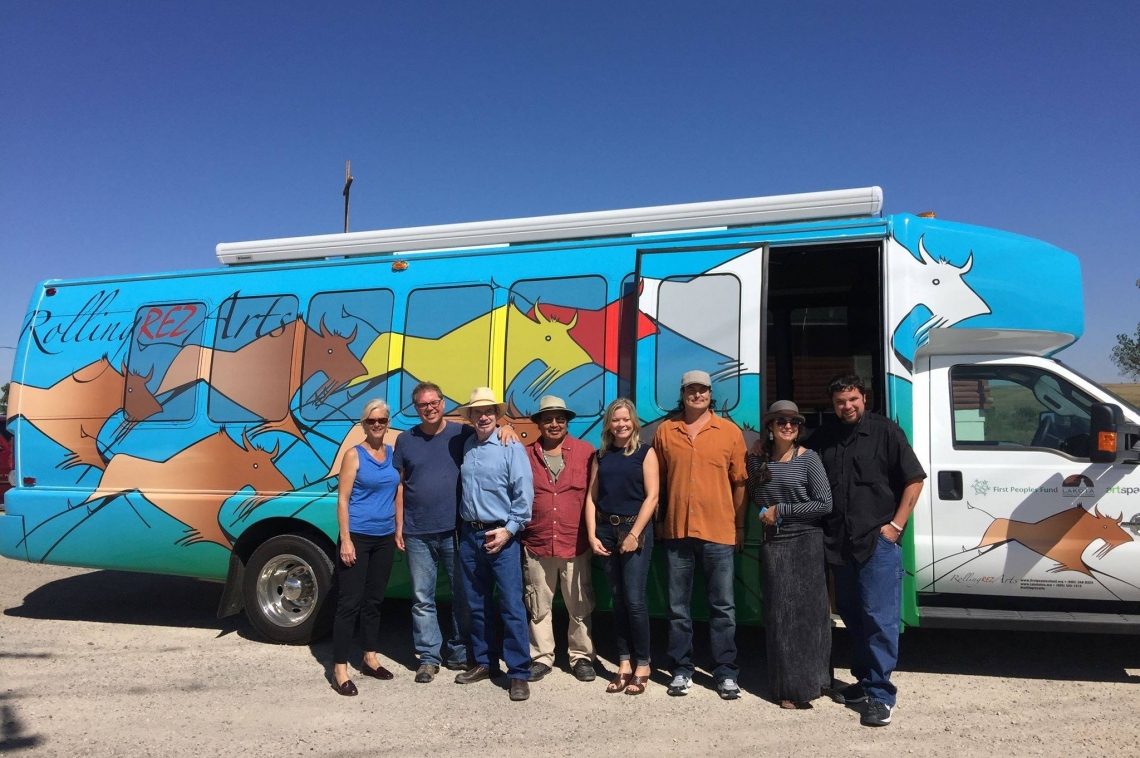
We’re excited to introduce a new blog format today. As anyone who’s journeyed through our ArtPlace website will see, we have a very diverse group of funded projects that make up the ArtPlace family. But as with many large and dispersed families, it’s often hard to connect with one another.
The Huddle recaps conversations where our ArtPlace funded projects and organizations came together to talk through topics, get advice, and perhaps even gossip a little. After each one we will use these blogs to recap the insights, questions, and provocations from these conversations.
This first one featured a conversation between Colin Hamilton of ArtSpace, Peter Mello of WaterFire Providence, Jeremy Staab of the First Peoples Fund, and Robert Gipe of the Higher Ground Project on the question: “What does the funding landscape look like for creative placemaking beyond ArtPlace?”
Whether through philanthropic donations, government funding, tax credits, or earned income, fundraising requires creativity, patience, and persuasion.
Even within their own communities, non-profits seeking funding have to be prepared to demonstrate their value. For example, Robert Gipe, of the Higher Ground Project, used theater to open dialogues about his area's prescription drug addiction epidemic. In order to receive the funding he needed from the college, he took action he knew couldn't be ignored.
"I took 20 people from our community to meet with the program officer in her home office,” he explained. “I took a group that represented the diversity of our community and talked about the importance of unity in our very divided community."
It worked for Robert. But going after bigger investors outside your usual local does require research into unknown territory and, of course, patience.
First People's Fund, an organization that supports native artists through grants and business skill training, spent over a year courting the Northwest Area Foundation after they were initially denied funding. "[They] told us they wouldn't fund the arts, they're not interested in the arts," Jeremy Stabb, of the First People's Fund, explained.
The key, Jeremy says, was to get NWAF to see FPF as more than an arts organization, and the arts as a valuable economic engine.
After almost two years of persistence, face-to-face meetings between Northwest’s board of directors and members of the tribal arts community finally convinced them that professional development training for artists could lead to significant economic growth.
"Once we were able to do that and establish other partnerships within the community, including financial institutions, we were able to demonstrate our capacity for cross-sector partnerships,” Jeremy told us. “We wanted to show how those artists are having such a huge impact on the tribal community's economic development and driving tourism and cultural revitalization."
As Colin Hamilton of Artspace, a fellow grantee and partner to FPF, pointed out, "One gift often makes things possible that weren't possible before. There always has to be something that comes first and it's remarkable how quickly that opens up other paths."
With Northwest's help, FPF was able to publish a market study on South Dakota's reservations and was recently awarded a three-year $1 million dollar grant. Colin refers to this as sequential funding; sometimes unlocking one major partnership has a fundraising domino effect.
"One of our lessons in chasing money is to be very attentive to what any single gift makes possible – not to see any of it as the end of a cycle," Colin says.
Colin has been at the forefront of Artspace's real estate development ventures. He recently worked on the Cowles Center project in downtown Minneapolis, revitalizing a historic Hennepin Avenue building into a performing arts complex with theaters, dance studios, and administrative space for 20 other nonprofits.
Though Artspace is a major developer with connections and partnerships galore, Colin still found that the community willing to fund the performing arts was "tiny". Like First People's Fund, Artspace's fundraising strategy adapted towards cross-sector appeal.
"We started to get some pretty significant contributions from people who told us that they couldn’t care less about dance, but they really did believe in [historic] Hennepin Avenue. That was a lesson to me that sometimes the reason people give you money is not always the reason you expect."
But what happens when funding doesn't come through?
Peter Mello, of WaterFire Providence , says not receiving funding was actually good for his organization.
An ongoing outdoor festival featuring a waterfront bonfire installation and spotlighting local performers and artists, WaterFire generates over $114 million dollars in economic impact for the state. While ArtPlace provided funding for programmatic activities, the grant we made didn’t include requested capital costs so we encouraged WaterFire to find community support for their building project. In response, WaterFire turned to their local government, using the success of their programming and the ArtPlace grant as leverage to get city and state investment in the capital project.
WaterFire has gone on to work with 8 other performing arts organizations and Rhode Island's state government to create a voter approved cultural facilities fund which provides $30 million dollars to cultural organizations for capital improvements.
"When you follow the thread all the way back it really leads to ArtPlace. It's what ArtPlace didn't fund that was the catalyst for letting us create a path to get all these other sources of funding lined up," Peter told us.
In the spirit of the panel as a community-strengthening exercise, Peter and Colin made a final point that all of the panelists could potentially leverage each other as resources. There’s no one-size-fits-all strategy for fundraising, but all signs point to strong cross-sector relationships as the most powerful tool in the fundraiser's arsenal.
Is there any information you wished we’d touched upon? What would you have asked the panelists? What advice would you give to your fellow creative placemaking practitioners?





